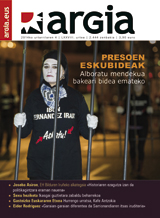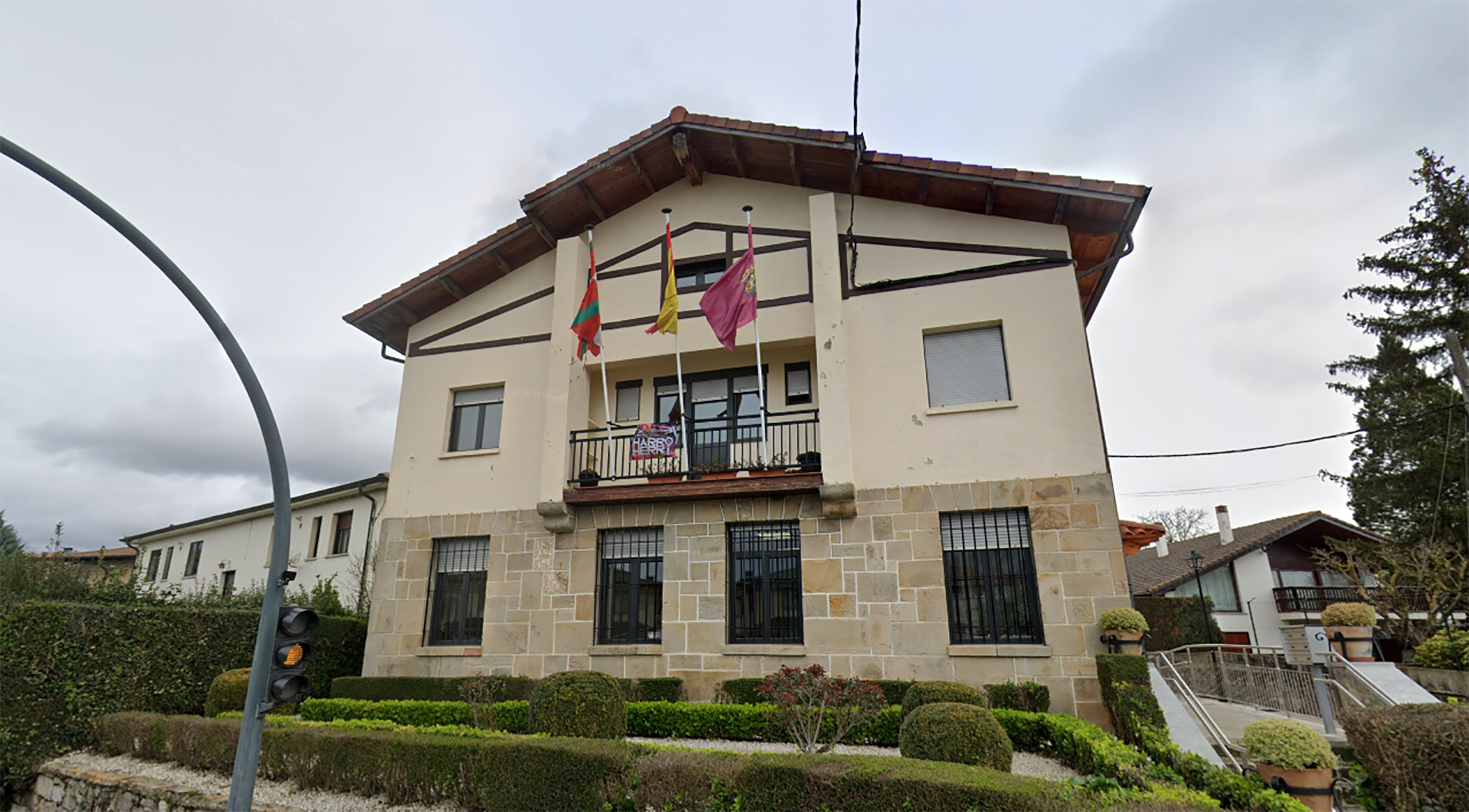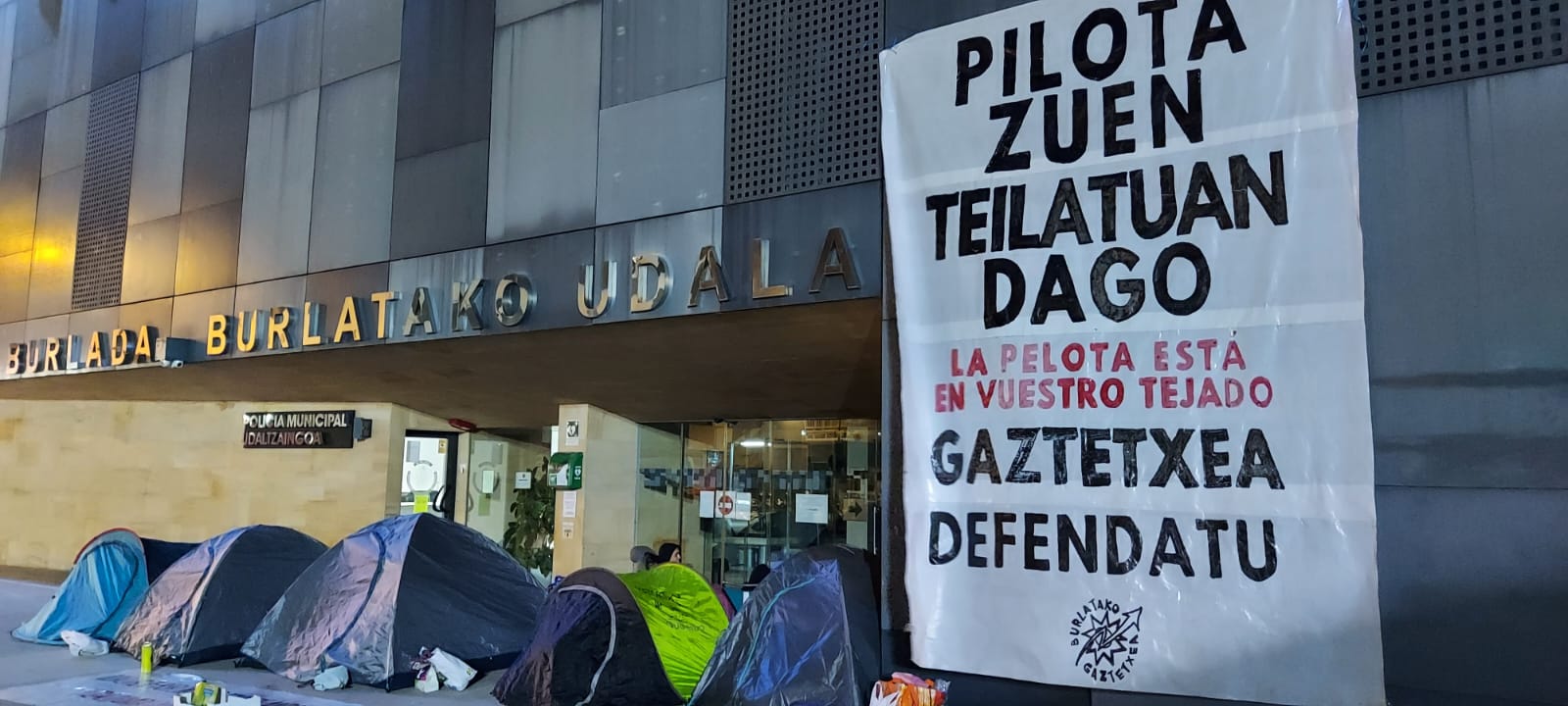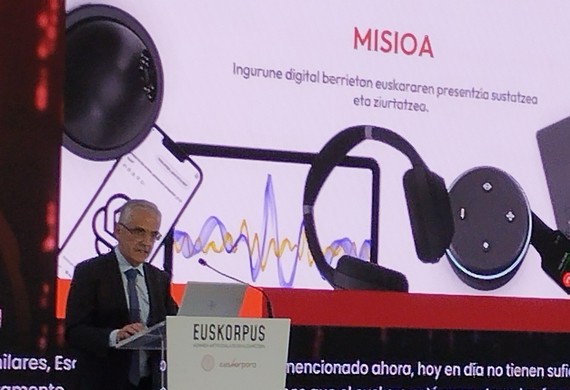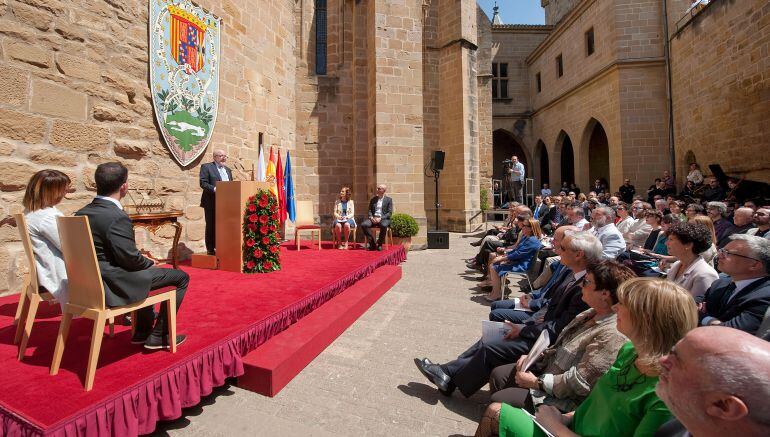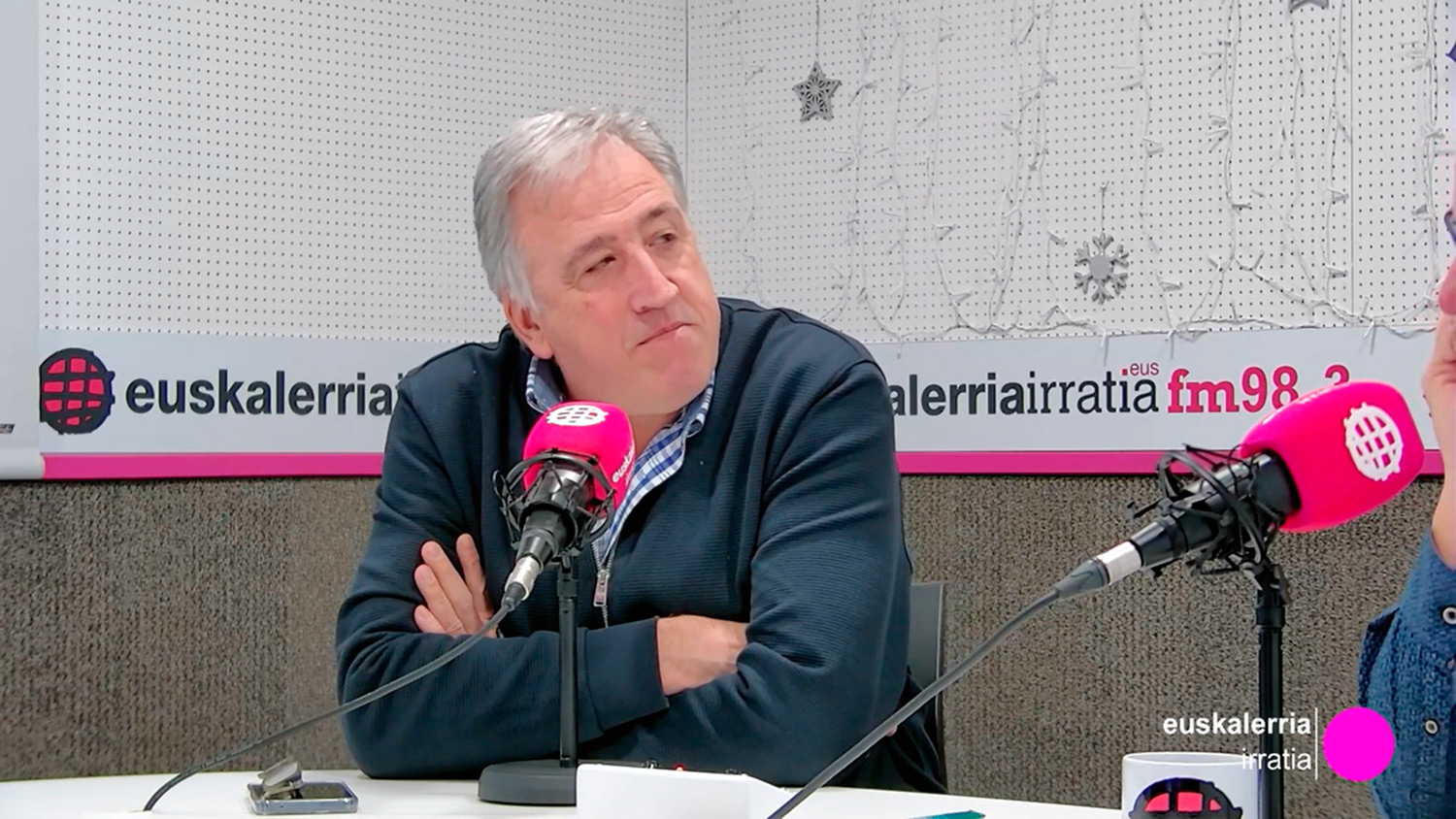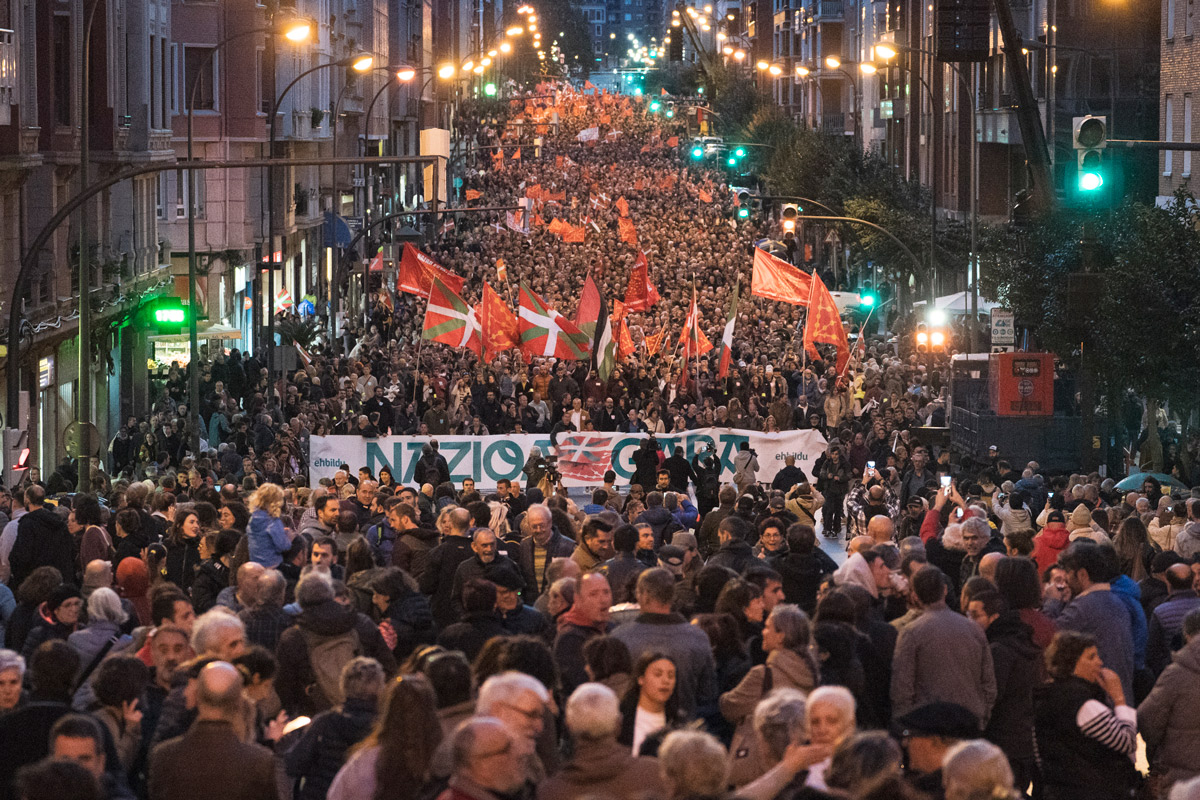"When I see the flag of Navarre and the ikurrina I'm Daltonic, I don't separate them"
- Historian, specialist in medieval art and in the conquest of Navarra, professor and now candidate of EH Bildu to the mayor of Pamplona.
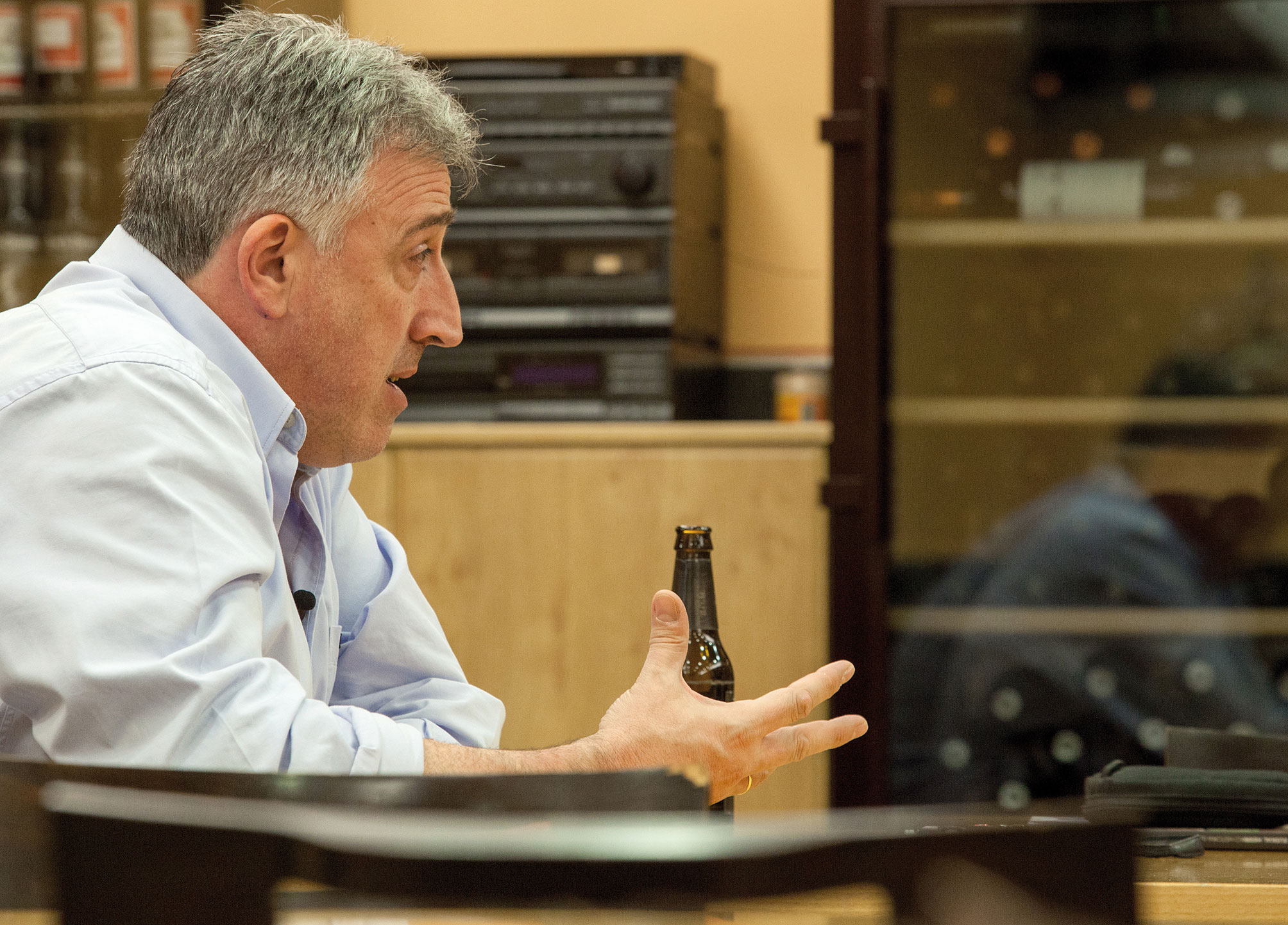
I heard that you were kicked out of the Jesuit school.
And also because of the escorts afterwards. The first was justified by my misconduct and the second by my political affairs. In '78, there were a lot of young people who were in politics.
So you were a naughty child?
Yeah, and I behaved like a kid. I have no problem accepting it. At 16-17, everything changed. Seeing that I was going against it, I started studying. In addition, at the time I found Art and History, the lessons I liked. I'll never thank my parents enough for insisting so much on their studies. In general, I had a very happy childhood in the Iturrama neighborhood, always playing in the street. In fact, my crew is not from school, but from neighborhood friends, and today it's a very rare issue.
Why did you study Art History?
I went to college wanting to study Medieval History, but in the art section I found what I really liked. That's why I consider myself an art historian. We spent eight years in Zarautz because my father found work there and I studied university studies between Donostia-San Sebastián and Zaragoza.
Why the thesis about towers and line palaces?
At the time when I was going to start making the thesis, as on many other occasions, it gave me a melancholic point and it occurred to me that I should know the seven peoples who were going to disappear with the swamp of Itoiz. The defensive architecture that I found there, especially the tribal tower, drew my attention immediately. Thus, at the end of the Middle Ages, I entered the 15th and 16th centuries and from there came the hobby for the conquest of Navarre.
Did you work at the Itoiz Coordinator?
I was also commissioned to draw up a catalogue of the historical-artistic heritage of the peoples who would be lost with the reservoir. That was my first job at the end of the studies.
“They won’t go through Itoiz,” but they passed. What was lost?
That of Asphyxia has been terrible. Six churches were destroyed, three Romanesque and three Gothic (Nagorekoa was rid of its presence in the upper part of the town), three houses of lineages, medieval bridges, houses, hermites… A terrible massacre. In my head is the church of Artozki, which was of great value, and the beautiful medieval village of Orbaiz, where Itoiz defended until the end. I still remember how the destruction machines of the Government of Navarra threw it all out. How could the Government itself break down those buildings that had so much value declared in the Monumental Catalogue? In addition, they were thrown to the ground, not underwater, as is often the case in most cases. It was an added punishment for the local population to resist.
I will never forget that I went to Artozki, to the house Juriko, to report my thesis to the owner of it, as I gathered the study of that house. When I arrived, they were emptying the house and dismantling whatever they could, because the machines were coming. The patron told me to take what she wanted, take it away, and I was deeply embarrassed. In addition, two elderly women came at that time to say goodbye to the house, crying. The end of this town was very sad: many people appeared making the last photos, they chained solidary and set the people on fire to avoid eviction… Everything was very hard. A battle. And that's what those in power did now. We should put their names on a big sheet to know who it is. And this has not been the only extermination: The destruction of the ruins of the Plaza del Castillo, the demolition of the fronton Euskal Jai… They have a tremendous lack of sensitivity and also want to be honored and good before society.
What valuation do you make of the initiative of the fifth anniversary of the conquest of Navarre in Nafarroa Bizirik and Nabarralde? Have you emptied the official version?
The need for new movements and contributions around the anniversary was felt beforehand. Over the years Nabarrista historiography has established its thesis: voluntary annexation, lack of resistance, the integration of Navarra in the new State in a natural way… but before Peio Esarte, Peio Monteano, Tomás Urzainki and other historians were working enthusiastically and we were eager to debate. To our astonishment, Nabarralde organized three congresses and many other things were done in silence. They spent three years without opening their mouths. Only a closed, very limited congress was organized, which responded everywhere. And the silence was made. Our assessment is unbeatable: now everyone knows what happened since 1512. People know that Navarre was a kingdom, an independent and modern state and that the conquest was totally illegal and unfair.
What is Navarre and what is Basque Country?
Navarre and the Basque Country are the two sides of the same coin. One has been culture, linguistics and the other political concreteness. I have no doubt that Navarre was the instrument created by the Basques or the Basques to survive as a people. They wanted to score a script, but the great powers around them forced them to completely change it.
What do you claim?
Independence must not be achieved, but must be restored. We need to reclaim our historic rights. Then Navarra, Euskal Herria… for me it’s the same. When you start to discuss what the political object is, I think we should be at the time of deciding what name to give to our independent people. To see where the capital is, in Pamplona or in Vitoria, if the flag is an ikurrina or another… That will come, but for the moment it is sterile to discuss it. When I see the ikurrina and the flag of Navarre, I'm a Dalton. I don't separate them. They have the same meaning.
But that can be hard for Vizcaínos, Alaveses…
There are more and more people in Bizkaia and Álava, and in Gipuzkoa there are a lot, who know that they are Navarros from the historical point of view. I would have no problem calling this imaginary state Navarre or Euskal Herria. Euskal Herria is a town, a fund, and Navarre was born at a certain point in the middle of the long history of Euskal Herria. You can't talk about Navarra before the 11th century. The Kingdom of Navarre has been the most successful, but not the only, political project of the Basques. And that can be claimed in Pamplona, Tudela, Galdakao or Maule.
The name of Reyno de Navarra is less and less used by the government, does it not?
Surely in 2012 they found that they were making too much mistakes with our messages. With this they have made a tribialization of history, and I do not know why they write and in Greek. If you want to proclaim the Kingdom, please proclaim it.
Why is there no leftover vascones in Pamplona?
In forty years the official archaeology has not found in Navarre anything that can be considered vascon, burial, pieces of ceramics, or any other material. You can go through the Museum of Navarra from the top down without finding the word baskoi. The same is true of the different museum sites: In Andelos, in the city of the Musas de Arellano, in the area of Eretas de Berbinzana... Before the arrival of the Romans, Estrabon, Tito Livio, Pliny, Silio Itálico… all the historians named us vascones, and now there is no trace of it. Amazing.
You've been a professor for 24 years at ikastola San Fermín.
I start as a professor of philosophy, and now I give that and art. There is a very nice atmosphere and this project I have accepted as we do. I feel very identified with this ikastola and I think it has been and is a reference of the Basque in the region of Pamplona and throughout Navarre. It is the oldest and the first to introduce high school.
Have the students changed a lot?
Today's teenagers or those of twenty years ago are very similar. The things of the skin change, but the activities of the day to day, their feelings, the ways of putting ourselves in front of us are repeated. And as for the compromise, it has not changed so much either.
And now the leap into politics. Why?
In the previous legislature, Eva Aranguren asked me to put me on the lists in a very low position and I accepted it. So, I felt the need to give an explanation to my students and it was very gratifying to know that they did not think in advance that I might be from HD Bildu. I've taught them a lesson and they don't know what my political thinking is. So far I have not been part of any political party, I have never been in a political meeting, but when they came from all three parties to ask me by common accord to work for my city, I said yes. I thought maybe I would regret admitting it, but I would certainly regret five minutes later if I didn't accept it. It is a decision taken with the family of the victim, who has died. It seemed to me that I can defend from politics my commitment to Navarre and the Basque Country. I walked in and out, not forever. I see myself teaching again in eight years, because I enjoy explaining Fray Angelico, Velázquez, Gothic… There I feel good. Historians, like journalists, have to defend our credibility and I think that from now on some, with contempt, will say that I am that historian of Bildu. But I am clear that knowledge of history is what has led me to politics and not the other way around, as in the case of others, who have approached politics to history to justify their political theses.
What would you change in Pamplona?
Pamplona needs a great cultural event. Some surrounding cities and much smaller ones have something eye-catching, and here's nothing. Pamplona is a desert in winter and summer. The unfortunate space of Count Rodezno should be turned around and something should be done about the historical memory, also the old bus station… but there are many other tasks: improving public transport, expanding bidegorris, encouraging communication between neighbourhoods… and, above all, strengthening social services. The X-ray we are receiving from the neighborhoods is enormous (unemployment, social exclusion, use of basic income, evictions, cases of malnutrition among children, suicide rate…). In the face of this situation, they asked Mayor Maya what is missing from Pamplona and he replied that he lacks the High-Speed Train. Culture also needs profound change. To begin with, removing the barriers to Basque culture and Basque culture. In the commercial sphere, after the opening of the English Court in 2005, between 2007 and 2013 a total of 1,800 stores were closed in Pamplona. Terrible. In gender-based violence, the protocols must be improved... It has happened to those of UPN that even when they have lost the majority they have wanted to rule as if they had a majority, without consulting or negotiating with anyone. Citizen participation is also null and void. The table of youth, the table of the elderly, the table of the Sanfermines … there are, but they do not do them any.
Joseba Asiron Saez, 1962ko apirilaren 14an Errepublikaren egunean jaioa eta ezkerra: “Eskuaren ezkertasuna apaizek indarrez aldarazi zidaten, baina buruarena ez”. Historialaria, Artean eta Nafarroako konkistaren garaian espezializatua, Nabarralde eta Nafarroa Bizirik ekimenetako partaidea, San Fermin ikastolako irakaslea duela 24 urtetik eta hainbat argitalpenen egilea da: Nafarroa, amets urratua komikia (Elkar, 2012), 50 fechas clave de la conquista de Navarra (Txalaparta, 2013), Martintxo Altzuetarekin batera Euskal Herriko historia ilustratua (Txalaparta, 2014) eta Agur, Iruñea (Txalaparta, 2014). Maiatzeko hauteskundeetan EH Bilduko hautagaia izanen da Iruñeko alkatetzarako.
“Beti moldatu naiz oso ongi gazteekin. Nik uste dut nire fisikoak ere lagundu didala. Handia izatea beti lagungarria izan zait ikasleen aurrean une zailetan serio jartzerakoan. Nerabeekiko interakzioa oso polita da”.
“Gu baino euskaldunagoak eta normalagoak dira gaztetxoak. Neska eta mutilak oso integratuak daude eta oso majoak dira. Hori bai, orain ikusten dena da planteamendu eskizofreniko bat: oso ongi bizi izan dira etxean eta, aldiz, haiei tokatuko zaien errealitatea oso gogorra da. Ez dute izango gurasoen etxean izan duten bizi maila. Horretaz jabetzea oso gogorra da”.
“Iruñean, baskoiek sortutako hiriko bihotzean, Gazteluko Plazan, lurpeko aparkalekua egin zutenean aztarna zeltiberiarrak, erromatarrak, musulmanak eta Erdi Arokoak agertu ziren baina baskoien arrastorik ez. Dena ezkutatzen dute, euskararekin egin nahi duten bezala. Hemen herriaren zati bat bere kulturaren aurka jotzen ari da. Autogorroto hori zerbait ulertezina da. Europa osoan ez da halako beste kasurik ezagutzen. Hego Amerikan edo Afrikako herri kolonizaturen batean agian bai, baina hemengo egoera oso arraroa da Europan”.
Koalizio abertzaleko hiru ordezkariek ohar baten bidez euren "frustrazioa" adierazi dute proiektu fotovoltaikoa ezin gelditzeagatik: "Egoera horren aurrean, ez gara legegintzaldia amaitzeko indarrez sentitzen". Proiektu honi ez! plataformak salatu du EH Bilduren... [+]
Arratzua-Ubarrundiako "Proiektu honi ez!" plataformak adierazpen hau kaleratu du, udalerri horretako EH Bilduko hiru zinegotziek dimisioa aurkeztu berritan. Izenburu hau darama testuak: "EH Bilduren moketako politika edo Iparra nola galdu".
Arratzua-Ubarrundia (Araba) herriko EH Bilduko hiru zinegotziek dimisioa eman dute Solariaren zentral fotovoltaikoagatik. Hau da hiru zinegotziek, Txetxu Zengotitabengoak, Laura Sanchok eta Javier Ruiz de Arkautek, herritarrei zuzendu dieten agur mezua.
EH Bildu agintean dagoen udalak gaztetxearen etorkizuna ziurtatzeko aterabide bat adosteari "uko" egin diola salatu du Burlatako Gazte Asanbladak. Beste hainbat gaztek udaletxe kanpoan kanpatu dute, eta goizean zehar bertara hurbiltzeko dei egin dute.
Mundua "oso azkar" aldatzen ari dela azaldu du Arnaldo Otegik, militarismorantz eta autoritarismorantz doala, eta norabide horren aurkako jarrera duela koalizio subiranistak.
Satorralaia plataformak Donostiako Metroaren Mirakontxa-Easo zatiko lanek “%164ko gainkostua” izan dutela salatu zuen joan den astean, eta, horren harira, EH Bilduk gainkostu hori argitzeko eskatu du, Eusko Legebiltzarrean erregistratutako galdera sorta baten bidez.
Euskorpora elkartearen eta Euskorpus proiektuaren abiatzeak hautsak harrotu ditu. Pello Otxandiano EH Bilduko Eusko Legebiltzarreko oposizio buruak Euskorpusena akatsa dela uste du, "ezjakintasuna edo estrategia klientelarra". EH Bilduk galdera sorta egin du... [+]
At the beginning of the month he did III. Congress in Pamplona. It is said to be the “ordinary congress” that serves to draw “non-ordinary conclusions”, or at least that is how they have received Zutunik in the paper, proposed by the leadership and unanimously approved... [+]









